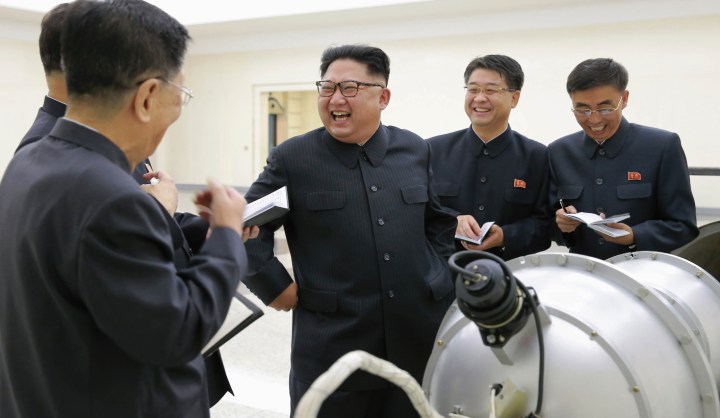South Africa
North Korea: What Kim Wants

To J. BROOKS SPECTOR, the increasingly unstable Korean crisis might benefit from the availability of an imaginary plot device found in the film, What Women Want. The crisis – and its possible solution – could also benefit from some more adult behaviour on the part of the protagonists.
Many readers may remember the film What Women Want, a fantasy rom-com vehicle for Mel Gibson and Helen Hunt (among others such as Alan Alda and Marisa Tomei). Gibson’s character, an alpha male, hard-charging, male chauvinist advertising executive, suddenly gains the ability to hear the most hidden thoughts of every woman near him. At first it drives him even crazier than he already is. But, soon enough, it becomes an enormous advantage to him in his fierce competition with Hunt’s character, in their duel for business success.
Don’t panic, this is not a retro movie critique. There is a real comparison here with international affairs right now. It is almost a dead certainty that foreign policy and intelligence analysts in Moscow, Beijing, Seoul, Tokyo, Washington, New York City at the UN (and probably elsewhere) are wishing they could read the inner thoughts and musings of one Kim Jong-un, the “Young Leader” of North Korea, as he frets and struts across the world stage with his brand-spanking new nuclear weaponry and the shiny missiles to deliver them. In the more public messages, he and his acolytes have been given to going on about fields of flame and nuclear-tipped gifts as a way of keeping things confused and chaotic.
Of course, a sympathetic cynic beyond the White House, in the US Congress, and in foreign embassies and chanceries around the globe, and the same collection of analysts puzzling over Kim’s thoughts might also be struggling to understand what, exactly, is in Donald Trump’s thoughts, given the range and confusion of his verbal and tweeted rants.
In Trump’s case, though, the comments have been less often either apocalyptic or Delphic, but, more often, have been contradictory statements that have left yawning gaps between the president’s views and those of his subordinates who have been trying to tamp down the fires their boss has been lighting. In the past several weeks alone, speaking about North Korea and Kim Jong-un, Trump and his crew have gone from calling the Korean leader a smart guy to being a madman prepping for war, and then back to someone they respect. And they have even said that they hoped they could share a hamburger and some mutual respect with him at a White House barbeque.
Aside from the obvious regional and global fears of the consequences of conventional (or nuclear) conflict arising out of the circumstances on the Korean peninsula, the lack of much useful information about the strategic calculations being undertaken in Pyongyang and the likelihood that much of what is being said is deliberately designed to confuse or confound, is similarly a source of great concern. So far, at least, the two principal actors in this Korean peninsula drama either do not have – or have failed to employ – any reliable means of making their realistic hopes, desires, intentions, objectives and fears clear to others.
Instead, so far, they have fallen back on duelling live fire military drills, massed military parades, missile test launches, naval patrols, threats aimed at third parties, and a handful of nuclear weapons tests to serve as the punctuation marks. As a result, nothing has lowered the tension or done anything to resolve the crisis. At least at this point, the conflict seems to yo-yo up and down, but without any logical conclusion, even as the ultimate trajectory is pointing upwards towards greater problems.
The other day, one analyst, speaking on an international news channel, argued that North Korea, under Kim’s direction, has been able to achieve “escalation dominance”. He largely has come to control the pace and content of the developments, the decibel count of the rhetoric, and the direction of the events. Virtually everything done by the US, the UN, South Korea and others has been in response to decisions initiated in Pyongyang. So far, Donald Trump has been unable to change that pattern.
The live fire drills held separately by South Korea or jointly with US forces, the South Korean naval patrol exercises, the US efforts to gain further sanctions against North Korea, the US deployment of the THAAD anti-missile system in South Korea, and the upgrades to South Korean and Japanese anti-missile defences have all come in response to North Korean missile launch tests or nuclear tests. And the tests have kept on coming, always at North Korea’s pace. The strategic initiative has been in the hands of that pudgy young man with the bizarre haircut, no military training and very little government experience, but who is in possession of a heretofore unknown, high level of strategic deviousness and subtlety.
And it isn’t just the Americans who have been caught off base by all this. The new South Korean president, Moon Jae-in, has been pushed back and forth between his political instincts to find a way forward for some form of negotiations with his opposite number, and his need to demonstrate military resolve in the face of North Korea’s missile and nuclear threats. Across the Japan Sea/East Sea in Tokyo, Prime Minister Shinzo Abe’s government, despite the sizeable percentage of people who still embrace the idea of a largely non-military Japan and many others who retain a deep dislike of Korea, has been impelled to decide to purchase anti-missile technologies from the US and to co-ordinate responses to Pyongyang’s missile tests as best they can with South Korea’s leader.
Meanwhile, the other two major powers in the region, Russia and China, have been caught uncomfortably in trying to maintain some influence over Pyongyang (and gaining an edge over the US) and simultaneously seeming to bow to growing international pressure against North Korea. The approaches of both nations also appear to be governed by fears of the disruptive regional costs from a serious collapse in North Korea such as large numbers of refugees fleeing that collapse as they seek shelter and safety. They are also driven by a reluctance to allow North Korea to be sufficiently pushed that regime change becomes a real possibility, as well as the fear of what happens to those loosely controlled nukes and missiles in such circumstances.
The Chinese have been opposed to any further tightening of sanctions, limiting North Korean exports, the pinching off of petroleum supplies, or imposing additional restrictions on financial controls. It is easy to visualise Chinese thinking that keeping open these windows serves as a means for them to keep their options open vis-à-vis North Korea in a longer game. The Russians, meanwhile, have less at stake in terms of trade, but clearly see that inserting themselves into this snarl with some possible ways forward gives them some strategic edge over the Chinese and takes greater control over America’s strategic options in the region. The Russians also argued vividly that further economic sanctions – as opposed to negotiations – would be useless since the North Korean government had, for example, in that massive famine in the 1990s, told inhabitants to eat grass if food was unavailable. Per the Russian view, the Pyongyang government is perfectly willing to absorb the shock if tighter sanctions were imposed.
Meanwhile, in Washington, the Trump administration continues to do itself no favours in the strategic coherence sweepstakes. On days when they are not excoriating North Korea and its leader, the Trumpster has taken to threatening South Korea that the US is considering tearing up the US-South Korea Free Trade Agreement, and that Korean President Moon is engaging in appeasement by his continued comments that he prefers negotiations to armed conflict. If that were not sufficient, Trump then threatened – improbably and unrealistically – that the US government would somehow close off trade with any country that continued to trade with North Korea.
But somehow, some way, at some time, this current Korean crisis will be drawn down. The sad truth is that there is no reasonable strategic approach in the air that will force North Korea to relinquish its nascent nuclear weaponry and missiles. Somehow, the North Koreans will be allowed to keep their dangerous toys and somehow, too, that possession will have to be woven into the larger framework of international deterrence and nuclear balances – in the way the world has gradually accepted the idea both India and Pakistan are not going to be surrendering their own nukes any time soon.
One approach being mooted by the Chinese and Russians – although not embraced by the US, South Korea or the Japanese, let alone Pyongyang – is a gradual freeze on further nuclear and missile developments by North Korea that would match a gradual drawdown of US forces on the peninsula and a winding down of US-South Korean joint military exercises. In this scenario, Vladimir Putin and Xi Jinping are both trying to be the adults in the room, despite the efforts of Kim and Trump to destroy things.
It is just possible that somewhere in this trial balloon is the starting point for a broader agreement. But that would almost certainly require something like face-to-face negotiations between the Kim and Trump administrations. And that will be fun indeed.
The standard measuring stick in evaluating a potential nuclear crisis has – for the past half century – been the Cuban Missile Crisis. And yes, that was a very close thing. But the current Korean crisis is not a stand-off between two nuclear-armed major nations and so the contours may not be the best analogy.
There is a more unsettling parallel to be considered. In 1914, the tiny truculent nation of Serbia became involved in an increasingly bitter confrontation with the Austro-Hungarian Empire, especially after a Serbian ultra-nationalist assassinated the heir to the Habsburg throne in Sarajevo. Despite the confusions of goals and statements, that confrontation eventually drew in every major European nation in a war that slaughtered millions, left the continent broken, and major empires destroyed. In the midst of the slaughter, foreign ministry officials across Europe found themselves asking how in the world this terrible thing had happened – or why.
Yes, the Korean crisis certainly has some comic opera elements to it, not least in the quality of the diplomatic language being employed. But the chances do exist that loose words and sloppy diplomacy can make things go way, way off the rails. And it will take fortitude to find a way past all the huffing, puffing and missile and warhead testing. DM
Photo: An undated photo released by state news agency North Korean Central News Agency (KCNA) on 03 September 2017 shows Kim Jong-un (3-R), leader of North Korea, purportedly guiding the work for nuclear weaponisation on spot, at an undisclosed location, North Korea. According to KCNA, Kim watched an H-bomb (hydrogen bomb), a multifunctional thermonuclear nuke with great destructive power, be loaded into an intercontinental ballistic missile (ICBM). Photo: EPA-EFE/KCNA

















